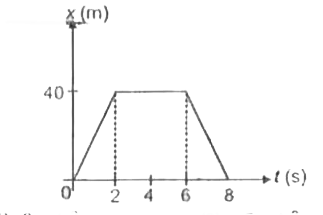The position x of a particle varies with time t as x=at2−bt3. The acceleration at time t of the particle will be equal to zero, where (t) is equal to .
2a3b
ab
a3b
zero
The correct Answer is:C
To find the time t when the acceleration of the particle is zero, we start with the position function given by:
x=at2−bt3
Step 1: Find the velocity V
The velocity V is the first derivative of the position x with respect to time t:
V=dxdt=ddt(at2−bt3)
Using the power rule for differentiation, we get:
V=2at−3bt2
Step 2: Find the acceleration a
The acceleration a is the derivative of the velocity V with respect to time t:
a=dVdt=ddt(2at−3bt2)
Again, using the power rule, we find:
a=2a−6bt
Step 3: Set the acceleration to zero
To find the time when the acceleration is zero, we set the equation for acceleration equal to zero:
0=2a−6bt
Step 4: Solve for t
Rearranging the equation gives us:
6bt=2a
Dividing both sides by 6b yields:
t=2a6b=a3b
Final Answer
Thus, the time t when the acceleration of the particle is zero is:
t=a3b
---
The velocity V is the first derivative of the position x with respect to time t:
The acceleration a is the derivative of the velocity V with respect to time t:
To find the time when the acceleration is zero, we set the equation for acceleration equal to zero:
Rearranging the equation gives us:
Thus, the time t when the acceleration of the particle is zero is:
Topper's Solved these Questions
- BOOK - CENGAGE PHYSICS ENGLISHCHAPTER - KINEMATICS-1EXERCISE - Graphical Concept17videos
KINEMATICS-1
- BOOK - CENGAGE PHYSICS ENGLISHCHAPTER - KINEMATICS-1EXERCISE - Graphical cancept1videos
KINEMATICS-1
- BOOK - CENGAGE PHYSICS ENGLISHCHAPTER - KINEMATICS-1EXERCISE - Subjective29videos
KINEMATICS-1
- BOOK - CENGAGE PHYSICS ENGLISHCHAPTER - GRAVITATIONEXERCISE - INTEGER_TYPE1videos
GRAVITATION
- BOOK - CENGAGE PHYSICS ENGLISHCHAPTER - KINEMATICS-2EXERCISE - Exercise Integer9videos
KINEMATICS-2
Similar Questions
The position x of a particle varies with time t as x=at2−bt3.The acceleration of the particle will be zero at time t equal to
View SolutionThe velocity of a particle is zero at time t = 2s, then
View SolutionIf the displacement of a particle varies with time as √x=t+3
View Solutionthe angular velocity omega of a particle varies with time t as ω=5t2+25rads. the angular acceleration of the particle att=1s is
View SolutionIf the displacement of a particle varies with time as x=5t2+7t.
Then find its velocity.View SolutionThe position of a particle moving along x-axis given by x=(−2t3−3t2+5)m. The acceleration of particle at the instant its velocity becomes zero is
View SolutionKinetic energy of a particle moving in a straight line varies with time t as K=4t2. The force acting on the particle
View SolutionThe coordinates of a particle moving in XY-plane vary with time as x=4t2,y=2t. The locus of the particle is a : -
View SolutionThe position of a particle along x-axis at time t is given by x=1+t−t2. The distance travelled by the particle in first 2 seconds is
View SolutionThe position (x) of a particle moving along x - axis veries with time (t) as shown in figure. The average acceleration of particle in time interval t = 0 to t = 8 s is
 View Solution
View Solution

